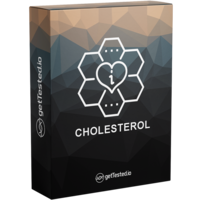Description
About Cholesterol Cholesterol is needed both as a building block for our steroid hormones and as an ingredient in our cell walls, as well as in the production of bile acid. The brain’s cells also need large amounts of cholesterol and if the body receives too little cholesterol, the cell division suffers and the brain does not function optimally. Cholesterol is produced naturally in the liver but can also be absorbed through food. Cholesterol is transported in the blood in so-called lipoproteins which are the transport particles of fats. High levels of LDL cholesterol (also known as ” bad cholesterol “) cause health problems such as high blood pressure and other cardiovascular diseases. It is important to keep track of the levels of cholesterol in the body and specifically to have a good balance between LDL and HDL. GetTested offers a simple test via blood test where you get answers to both your cholesterol value and the balance between these values. What the Cholesterol Test measures With this test you get answers to the following values: Cholesterol LDL cholesterol HDL cholesterol LDL / HDL ratio Triglycerides The function of Cholesterol Cholesterol is a lipid, or fatty substance, that is produced in the liver and stabilises our cell membranes and contributes to fat metabolism. Cholesterol is important for the production of steroid hormones (estrogen/oestrogenand cortisol) and conversely for vitamin D. Cholesterol is ingested to some extent through the diet but is also synthesised in the body. It has low solubility in water and can therefore not travel freely in the blood and in order for it to be transported in the blood, the cholesterol is encapsulated in so-called carrier proteins (lipoproteins) which have a water-soluble outside and fat-soluble inside. These carrier proteins act as “suitcases” from different destinations to different destinations. There are different proteins with different functions that bring cholesterol to different targets in the body. The good and bad Cholesterol All cells in your body must have cholesterol to be able to be built. Cholesterol is also needed when the body produces hormones, bile acids and certain vitamins. As cholesterol is a fat-soluble substance, it needs to be packed into so-called carrier proteins (lipoproteins) in order to be transported in the blood. The two carrier proteins that transport cholesterol in the body are LDL ( low-density lipoprotein) and HDL ( high-density lipoprotein ). These have different functions and different transportation purposes in the body. Something that they both have in common is their water-soluble exterior and fat-soluble interior. LDL protein is released from the liver and carries cholesterol and triglycerides to the cells while HDL proteins instead transport cholesterol from tissues to the liver. There used to be a lot of talk about the good and the bad cholesterol found in various “good” and “bad” foods. Today, more focus is placed on the balance between HDL and LDL and if you analyse cholesterol, it is the so-called total cholesterol measured, i.e. both HDL and LDL levels. If you have high levels of LDL (especially in relation to HDL levels), the risk of suffering from heart and vascular diseases increases. The more LDL you have in your body, the greater the risk that LDL will oxidise (ie be affected by free radicals) or become rancid. If this happens, LDL becomes sticky and sticks to the inside of the walls of blood vessels (so-called plaque) and causes inflammation. Inflammation of the blood vessels can cause atherosclerosis and can eventually cause cardiovascular disease.


